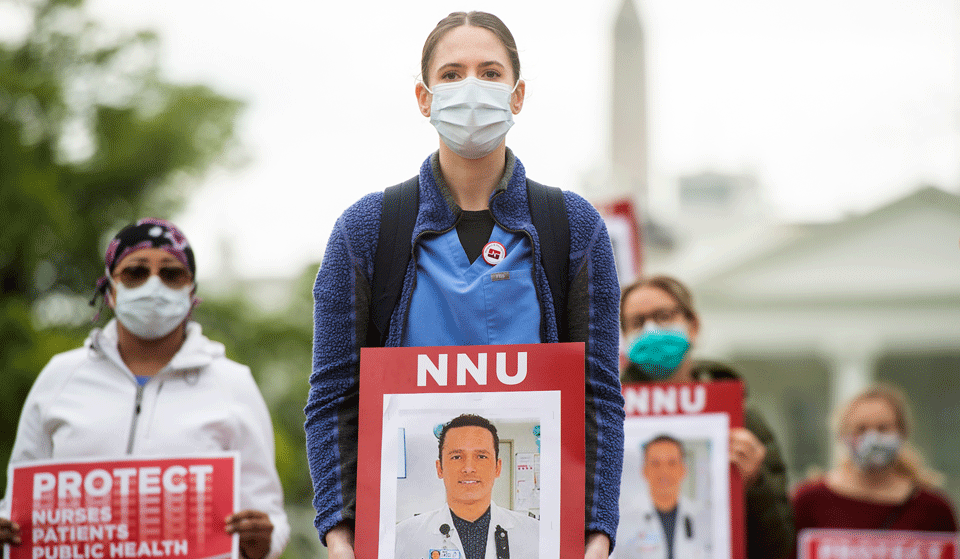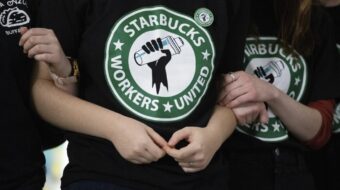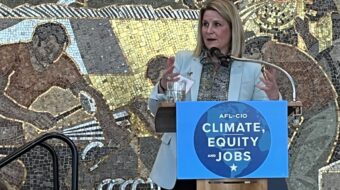
WASHINGTON— Donald Trump’s Occupational Safety and Health Administration (OSHA) is deliberately failing to force firms nationwide to protect their workers – and the public at large — against the coronavirus pandemic, a panel of speakers say.
And the result, they add, is needless deaths and illnesses not just among the workers themselves, but in the nation at large, due to “community spread” when workers unknowingly catch the virus on the job and then go home to their families and neighbors.
The speakers, Rep. Rosa DeLauro, D-Conn., Teachers (AFT) President Randi Weingarten, Steelworkers Secretary-Treasurer John Shinn, Obama-era OSHA administrator Dr. David Michaels, and environmentalists Michael Bruhn of the Sierra Club and Jason Walsh of the BlueGreen Alliance, leveled that indictment on Workers Memorial Day, April 28.
Workers Memorial Day marks the enactment of the Occupational Safety and Health Act 50 years ago. Workers and their allies – especially unions – usually use it to honor and commemorate workers who were killed on the job the year before.
The most recent official data, for calendar 2018, put that total at 5,250, though unofficial estimates are far higher. And those workers were usually killed in transportation accidents, or by falls.
Not this year.
The AFL-CIO and other unions have been keeping running lists of their members who die from the coronavirus pandemic. They number in the thousands.
They include at least 50 nurses, according to National Nurses United, 38 AFSCME members, most of them in metro New York, more than 75 AFT teachers, paraprofessionals, and bus drivers, and other workers in trucking, groceries, at USW-represented oil refineries and chemical plants, in warehouses and – especially now – in beef and pork production plants. Among others.
The toll is so great the federation developed a Workers Memorial Day toolkit with both data on the virus and how workers can combat it http://aflcio.org/2020-wmd-toolkit.
Those thousands of ill workers are among the 1,107,871 U.S. residents who have sickened from the coronavirus, from the time the count began three months ago until 1 pm on April 28. Of those 57,175 have died. That’s approximately equal to the number of U.S. service members’ deaths in the 20 years of the Vietnam/Indochina War, 1955-75.
And what is Trump’s OSHA doing about all this? Issuing “guidance,” which is not mandatory, to industries on how to protect their workers. There’s no enforcement, no stick, the speakers said. And that steamed the six panelists in the tele-press conference.
“OSHA is missing in action,” said Walsh, the executive director of the alliance, founded by USW and Bruhn’s group, the Sierra Club. Its directives are “non-enforceable by design while workers are putting their lives on the line.”
“This has been a life-or-death issue for ‘essential workers,’ but now it will be for all workers,” he added.
“OSHA’s job is to ensure the health and safety of every worker,” DeLauro said, citing the OSHA Act which established the agency. “The guidance is non-binding and we’re in a pandemic.”
Weingarten was particularly incensed because the Obama administration’s OSHA, led by Dr. Michaels – a public health specialist – started work on a mandatory standard to order health care facilities, such as hospitals and nursing homes, to protect their workers against airborne pathogens, such as the coronavirus. Trump’s OSHA shelved it. Yet, “in some states, close to 20% of coronavirus-ill workers are health care workers.”
“USW members continue to go to work in paper plants, oil refineries, and power plants” without protective gear, Shinn added. “Those who are working are endangering themselves and their families” through potential exposure to the virus.
“And those who are not are worrying when their jobs will be there,” as they’re among the 26.5 million workers, and counting, whom widespread closures to stop the coronavirus’s spread have added to the nation’s unemployment lines.
OSHA can’t do anything about the jobless, but it can protect workers who still toil, the speakers said.
Instead, the Trump government went completely in the other direction, one union leader reported.
The administration added insult to illness on the afternoon of Workers Memorial Day by invoking the Defense Production Act to force the meat and pork plants to stay open – though their workers often toil without masks and always close to each other. Both are perfect conditions for community spread of the virus.
“We only wish this administration cared as much about the lives of working people as it does about meat, pork, and poultry products,” said Stuart Appelbaum, president of the Retail, Wholesale, and Department Store Union. His union, like its parent United Food and Commercial Workers, represents meat, pork, and chicken plant workers, along with grocery workers.
“When poultry plants shut down, it’s for deep cleaning and to save workers’ lives. If the administration had developed meaningful safety requirements early on as they should have and still must do, this would not even have become an issue. Employers and government must do better. If they want to keep the meat and poultry supply chain healthy, they need to make sure that workers are safe and healthy,” Appelbaum added. Forcing the plants to reopen without enforcing a plan to guarantee worker safety – the other half of the equation – can cause an even sharper upward spike of coronavirus infection in the plants themselves and in the communities that surround them. Communities surrounding those plants already have an infection rate higher than the rate in the other 75 percent of counties in the U.S.
Weingarten and others demanded an emergency standard ordering firms that employ the essential workers — nurses and others – institute protection and safety plans, followed by a wider standard against such airborne illnesses that covers all workplaces.
And they demanded not just higher standards, but a lot more enforcement.
And if OSHA won’t develop an emergency standard on its own, Congress, by passing HR6559, introduced last week ordering the agency to do so, will force it on Trump, the panel said.
By contrast, Trump’s OSHA, added Weingarten, “has even failed to develop training programs” for firms and workers to protect themselves against community spread of the coronavirus.
And it certainly doesn’t require firms to buy workers personal protective equipment (PPE), notably the N95 face masks and accompanying respirators, which could protect them against 95% of the airborne viruses, she noted.
It can also start with a more accurate count of those who sickened and died, Dr. Michaels said, especially women and people of color, who are disproportionately hit.
There is no such accuracy, he declared, because a firm only must report an injury, illness, or death on the job if it actually occurs on the job, within 24 hours. But if a worker gets sick on the job, but doesn’t develop the illness until later, then goes to a hospital and dies, he explained, she’s not counted.
OSHA is also supposed to protect whistleblowers who report job-caused illnesses and injuries, he noted. “But when workers are fired for filing safety complaints” about lack of coronavirus protection, “this administration is mute.” They’ve filed 3,000 and counting.
The solution to all this is not just more money, though OSHA needs that, said DeLauro, who chairs the House Appropriations subcommittee that actually helps decide and direct funds for the Labor Department and its agencies, including OSHA.
It also needs leadership and accountability. DeLauro promised to add dollars for OSHA to the budget for fiscal 2021, which starts Oct. 1. Trump wanted to cut OSHA money for this year, but her subcommittee stopped that scheme.
But OSHA hasn’t had an administrator since Michaels stepped down at the end of the Obama administration three years ago and Trump hasn’t bothered to send up a new nominee since the Senate pigeonholed his former choice last year. “And half of its senior positions are empty, too,” he said.
And while there was “a pandemic” of deaths from regular causes – the falls, the accidents and so on – in prior years, “This pandemic has underscored the value of a safe and healthy workplace,” especially for workers, Michaels said, who have been undervalued until now.
Like free stuff? So do we. Here at People’s World, we believe strongly in the mission of keeping the labor and democratic movements informed so they are prepared for the struggle. But we need your help. While our content is free for readers (something we are proud of) it takes money — a lot of it — to produce and cover the stories you see in our pages. Only you, our readers and supporters, can keep us going. Only you can make sure we keep the news that matters free of paywalls and advertisements. If you enjoy reading People’s World and the stories we bring you, support our work by becoming a $5 monthly sustainer today.












Comments